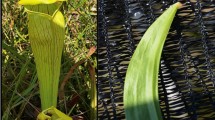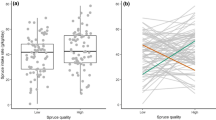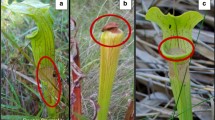Abstract
The North American pika, Ochotona princeps, is a generalist herbivore that simultaneously selects two distinct diets: one consumed immediately (summer diet), the other harvested, transported, and stored for later consumption (winter diet). I investigated factors influencing diet selection at two sites on the West Knoll of Niwot Ridge, Boulder County, Colorado during 1991 and 1992. The composition of summer and winter diets differed significantly from each other as well as from the relative abundance of food items in the environment. Thus, pikas were not foraging randomly for either diet. To explore winter and summer diet selection, I tested two existing hypotheses: (1) that plant morphology restricts the winter diet breadth to plants that are easily harvested and large, and thereby maximizes the amount collected per foraging effort, or (2) to compensate for nutrients lost during storage, pikas bias their winter diet with high-nutrient species. I also tested the hypothesis that plant secondary compounds may be higher in the winter diet either because they function as preservatives or because pikas delay consumption of these species until the toxins degrade. For individual dietary items, I measured energy, nitrogen, water, fiber, total phenolic, condensed tannin, and astringency contents. There was little evidence to suggest that morphology excluded plants from the winter diet. Plant size was not a good predictor of abundance in the winter diet. Even after harvesting costs had been experimentally removed, cushion plants were still not included in the winter diet. There was weak support for an effect of nutrients on winter diet selection; in three of four cases, the winter diet was significantly lower in water and higher in total energy content as predicted by the nutrient compensation hypothesis. However, other nutrients exhibited no consistent pattern. Nutrients were not reliable predictors of the winter diet in multiple regression analyses. There was strong support for the hypothesis of manipulation of secondary compounds. The winter diet was significantly higher in total phenolics and astringency. Total phenolics were consistent predictors of the winter diet in multiple regression analyses. The winter diets of six additional pika populations contained plant species high in secondary compounds. The results suggest that pikas preferentially select plants with high levels of secondary compounds for their winter diet, possibly because the presence of such compounds promotes preservation of the cache. This behavior may also enable the exploitation of an otherwise unusable food resource, i.e., toxic plants.
Similar content being viewed by others
References
Anderson HH, Sedell JR, Roberts LM (1978) The role of aquatic vertebrates in the processing of wood-debris in coniferous forest streams. Am Midl Nat 100: 64–82
Balanger J, Bergeron J (1987) Can alkaloids and tannins in plants influence food choice of meadow voles Microtus pennsylvanicus? Canad J Zool 65: 375–378
Belovsky GE (1978) Diet optimization in a generalist herbivore the moose. Theor Popul Biol 14: 105–134
Belovsky GE (1981) Food selection by a generalist herbivore: the moose. Ecology 62: 1020–1030
Belovsky GE (1984) Herbivore optimal foraging: a comparative test of three models. Am Nat 124: 97–115
Bowman WD, Theodose TA, Schardt JC, Conant RT (1993) Constraints of nutrient availability on primary production in two alpine tundra communities. Ecology 74: 2085–2097
Broadbrooks HE (1965) Ecology and distribution of the pikas of Washington and Alaska. Am Midl Nat 73: 299–335
Cameron GN, LaPoint TW (1978) Effects of tannins on the decomposition of Chinese tallow leaves by terrestrial and aquatic vertebrates. Oecologia 32: 349–366
Charnov EC (1976a) Optimal foraging: attack strategy of a mantid. Am Nat 110: 141–151
Charnov EL (1976b) Optimal foraging: the marginal value theorem. Theor Popul Biol 9: 129–136
Coley PD (1983) Herbivory and defensive characteristics of tree species in a lowland tropical forest. Ecol Monogr 53: 209–233
Coley PD, Bryant JP, Chapin FS III (1985) Resource availability and plant antiherbivore defenses. Science 313: 889–891
Conner DA (1983) Seasonal changes in activity patterns and the adaptive value of haying in pikas (Ochotona princeps). Can J Zool 61: 411–416
Cooper SM, Owen-Smith R, Bryant JP (1988) Foliage acceptability to browsing ruminants in relation to seasonal changes in the leaf chemistry of woody plants in a South African savanna. Oecologia 75: 336–342
Dearing MD (1995) Factors governing diet selection in a herbivorous mammalian herbivore, the North American Pika, Ochotona princeps. PhD dissertation, University of Utah
Dearing MD, Schall JJ (1992) Testing models of optimal diet assembly by the generalist herbivorous lizard Cnemidophorus murinus. Ecology 73: 845–858
Duke JA (1985) CRC handbook of medicinal herbs. CRC Press, Boca Raton, Fla
Elliott CL (1980). Quantitative analysis of pika (Ochotona princeps) haypiles in central Idaho. Northwest Sci 54: 207–209
Emlen JM (1966) The role of time and energy in food preference. Am Nat 100: 611–617
Freeland WJ, Janzen DH (1974) Strategies in herbivory by mammals: the role of plant secondary compounds. Am Nat 108: 269–289
Ganzhorn JU (1988) Food partitioning among Malagasy primates. Oecologia 75: 436–450
Gershenzon G, Croteau R (1991) Terpenoids. In: Rosenthal GA, Berenbaum MR (eds) Herbivores: their interactions with secondary plant metabolites, vol 1. Academic Press, San Diego, pp 165–220
Gibbs RD (1974) Chemotaxonomy of flowering plants. McGill-Queen's University Press, Montreal
Glantz SA, Slinker BK (1990) Primer of applied regression and analysis of variance. McGraw-Hill, New York
Glasby JS (1991) Dictionary of plants containing secondary metabolites. Taylor and Francis, London
Goering HK, Van Soest PJ (1970) Forage fiber analyses (apparatus, reagents, procedures and some applications). (USDA agricultural handbook No. 379) USDA, Washington
Goldberg M, Tabroff NR, Tamarin RH (1980) Nutrient variation in beach grass in relation to beach vole feeding. Ecology 61: 1029–1033
Hafner DJ, Sullivan RM (1995) Historical and ecological biogeography of Nearctic pikas (Lagomorpha: Ochotonidae) J Mammal 76: 302–321
Haga R (1960) Observations on the ecology of the Japanese pika. J Mammal 41: 200–212
Hagerman AE, Butler LG (1978) Protein precipitation method for the quantitative determination of tannins. J Agric Food Chem 26: 809–812
Hagerman AE, Butler LG (1991) Tannins and lignins. In: Rosenthal GA, Berenbaum MR (eds) Herbivores: their interaction with secondary plant metabolites, vol 1. Academic Press, San Diego, pp 355–388
Huntly NJ (1987) Influence of refuging consumers (pikas: Ochotona princeps) on subalpine meadow vegetation. Ecology 68: 274–283
Huntly NJ, Smith AT, Ivins BL (1986) Foraging behavior of the pika (Ochotona princeps), with comparisons of grazing versus haying. J Mammal 67: 139–148
Johnson AE, James LF, Spillet J (1976) The abortifacient and toxic effects of big sagebrush (Artemisia tridentata) and juniper (Juniperus osteosperma) in domestic sheep. J Range Manage 29: 278–280
Lewis HL, Elvin-Lewis MPF (1977) Medical botany. Wiley, New York
MacArthur RH, Pianka ER (1966) On optimal use of a patchy environment. Am Nat 100: 603–609
McArthur CA, Hagerman AE, Robbins CT (1991) Physiological strategies of mammalian herbivores against plant defenses. In: Palo RT, Robbins CT (eds) Plant defenses against mammalian herbivory. CRC Press, Boca Raton, Fla
Marken Lichtenbelt WD van (1993) Optimal foraging of a herbivorous lizard, the green iguana in a seasonal environment. Oecologia 95: 246–256
Marquis RJ, Batzli GO (1989) Influence of chemical factors on palatability of forage to voles. J Mammal 70: 503–511
Meyer M, Karasov WH (1989) Antiherbivore chemistry of Larrea tridentata: effects on woodrat (Neotoma lepida) feeding and nutrition. Ecology 70: 953–961
Millar JS, Zwickel FC (1972) Characteristics and ecological significance of hay piles of pikas. Mammalia 36: 657–667
Milton K (1981) Factors influencing leaf choice by howler monkeys: a test of some hypotheses of food selection by generalist herbivores. Am Nat 114: 363–378
Palo RT, Robbins CT (1991) Plant defenses against mammalian herbivory. CRC Press, Boca Raton, Fla
Pearcy RW, Ehleringer J, Mooney HA, Rundel PW (1989) Plant physiological ecology, Chapman and Hall, London
Porter LJ, Hrstich LN, Chan BC (1986) The conversion of procyanidins and prodelphinidins to cyanidin and delphinidin. Phytochemistry 25: 223–230
Post D (1993) Detection differences in nutrient concentrations by eastern woodrats (Neotoma floridana). J Mammal 74: 493–497
Randolph JC, Cameron GN, Wrazen JA (1991) Dietary choice of a grassland herbivore, Sigmodon hispidus. J Mammal 72: 300–313
Reichman OJ (1988) Caching behavior of eastern woodrats, Neotoma floridana, in relation to food perishability. Anim Behav 36: 1525–1532
Robbins CT (1993) Wildlife feeding and nutrition, 2nd edn. Academic Press, San Diego
Rosenthal GA (1991) Nonprotein amino acids as protective allelochemicals. In: Rosenthal GA, Berenbaum MR (eds) Herbivores: their interactions with secondary plant metabolites, vol 1. Academic Press, San Diego, pp 1–34
Rosenthal GA, Berenbaum MR (1991) Herbivores: their interactions with secondary plant metabolites, vol 1. The chemical participants. Academic Press, San Diego
Rosenthal GA, Berenbaum MR (1992) Herbivores: their interactions with secondary plant metabolites, vol 2. Ecological and evolutionary processes. Academic Press, San Diego
Roy J, Bergeron J (1990) Branch-cutting behavior by the vole, Microtus pennsylvanicus. J Chem Ecol 16: 735–741
Schall JJ, Ressel SJ (1991) Toxic plant compounds and the diet of the predominantly herbivorous whiptail lizard, Cnemidophorus murinus. Copeia 1: 111–119
Schwartz CC, Regelin WL, Nagy JG (1980) Deer preference for juniper forage and volatile treated foods. J Wildl Manage 44: 114–120
Shapiro SS, Wilk MB (1965) An analysis of variance test for normality (complete samples). Biometrika 52: 591–611
Smallwood PD, Peters WD (1986) Grey squirrel food preferences: the effect of fat and tannin concentration. Ecology 67: 168–174
Southwick CH, Golian SC, Whitworth MR, Halfpenny JC, Brown R (1986) Population density and fluctuations of pika (Ochotona princeps) in Colorado. J Mammal 67: 149–153
Stephens DW, Krebs JR (1986) Foraging theory. Princeton University Press, Princeton, NJ
Stout RJ (1989) Effects of condensed tannins on leaf processing in mid-latitude and tropical streams: a theoretical approach. Can J Fish Aquat Sci 46: 1097–1106
Swain T (1979) Tannins and lignins. In: Rosenthal GA, Janzen DH (eds) Herbivores: their interactions with secondary plant metabolites. Academic Press, San Diego, pp 657–718
Swift MJ, Heal OW, Anderson JM (1979) Decomposition in terrestrial ecosystems. University of California Press, Berkeley
Tahvanainen J, Helle E, Julkunen-Tiitto E, Lavola A (1985) Phenolic compounds of willow bark as deterrents against feeding by mountain hare. Oecologia 65: 319–323
Torti SD, Dearing MD, Kursar TA (1995) Extraction of phenolics: a comparison of methods. J Chem Ecol 21: 117–125
Turner NJ, Szczawinski AF (1991) Common poisonous plants and mushrooms. Timber Press, Portland, Oreg
Van Soest PJ (1963) Use of detergents in the analysis of fibrous feeds. II. A rapid method. J Assos Off Agric Chem 46: 829–835
Walker MD, Webber PJ, Arnold EH, Ebert-May D (1994) Effects of interannual climate variation on aboveground phytomass in alpine vegetation. Ecology 75: 393–408
Waterman PG, Mole S (1994) Analysis of phenolic plant metabolites. Blackwell, Oxford
Weast RC, Astle MJ, Beyer WH (1987) CRC handbook of chemistry and physics, (67th edn). CRC Press, Boca Raton, Fla
Weckerly F (1994) Selective feeding by black-tailed deer: forage quality or abundance? J Mammal 75: 905–913
West EW (1980) Adaptive patterns in behavior of the Sierran pika, Ochotona princeps. PhD dissertation, University of California, Davis
Williams K, Percival F, Merino J, Mooney HA (1987) Estimation of tissue construction cost from heat of combustion and organic nitrogen content. Plant Cell Environ 10: 725–734
Willig MR, Lacher TE Jr (1991) Food selection of a tropical mammalian folivore in relation to leaf nutrient content. J Mammal 72: 314–321
Wrangham RW, Waterman PG (1981) Feeding behavior of vervet mokeys on Acacia tortilis and Acacia xanthophloea: with special reference to reproductive strategies and tannin production. J Anim Ecol 50: 715–731
Yosef R, Whitman DW (1992) Predator exaptations and defensive adaptations on evolutionary balance: no defense is perfect. Evol Ecol 6: 527–536
Author information
Authors and Affiliations
Rights and permissions
About this article
Cite this article
Dearing, M.D. Disparate determinants of summer and winter diet selection of a generalist herbivore, Ochotona princeps . Oecologia 108, 467–478 (1996). https://doi.org/10.1007/BF00333723
Received:
Accepted:
Issue Date:
DOI: https://doi.org/10.1007/BF00333723




